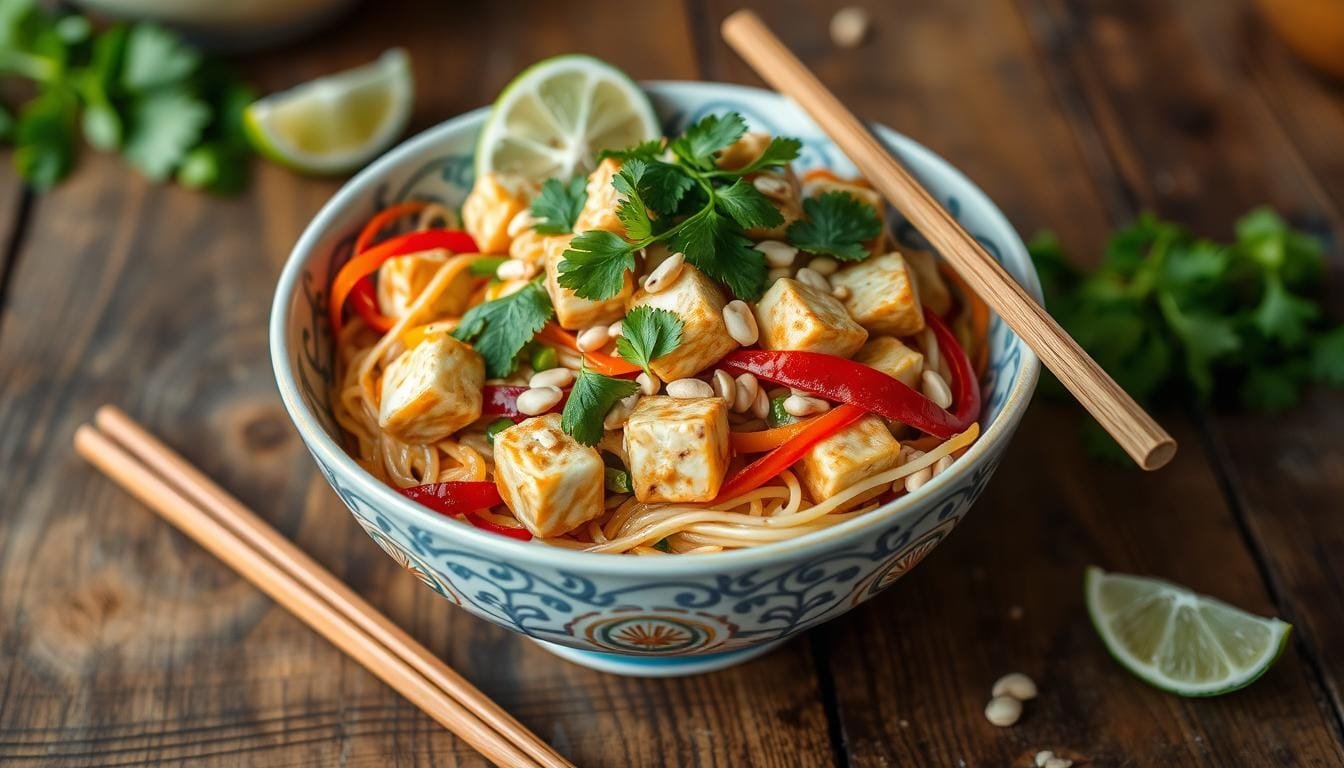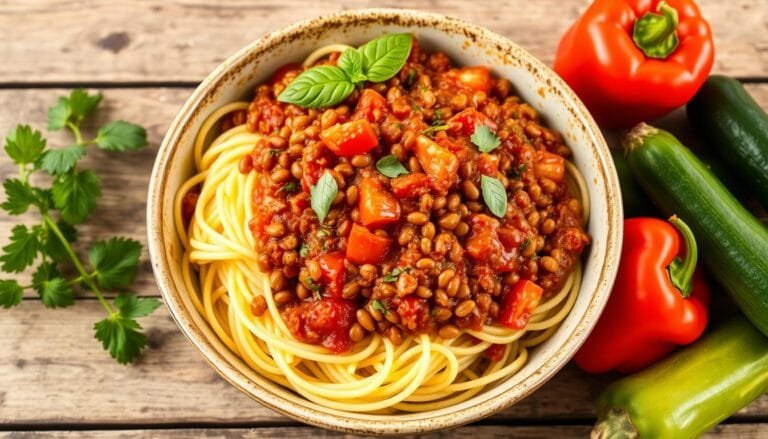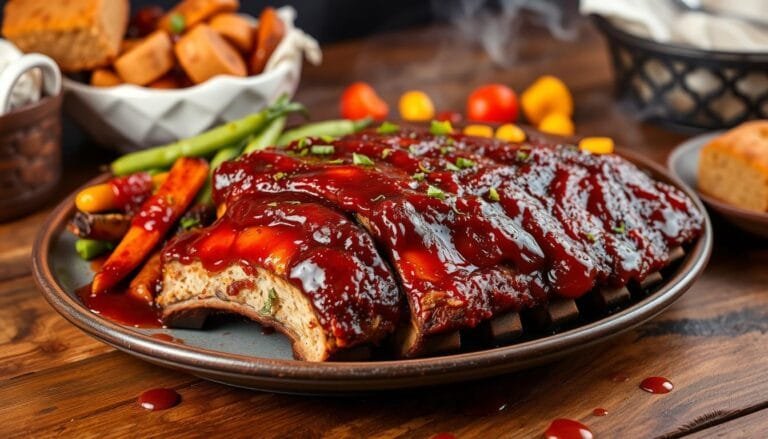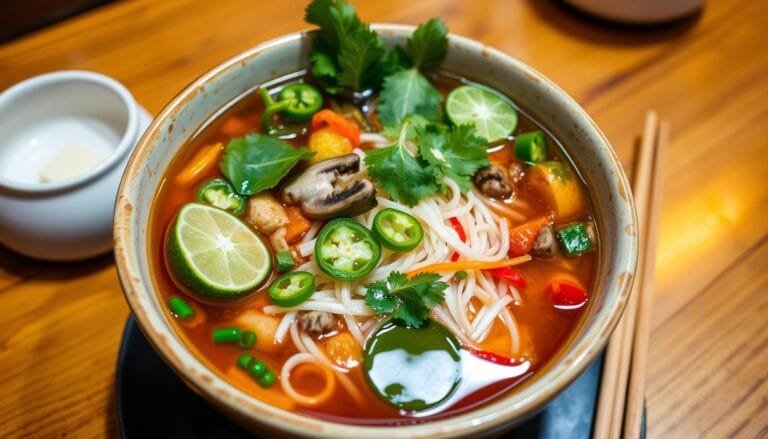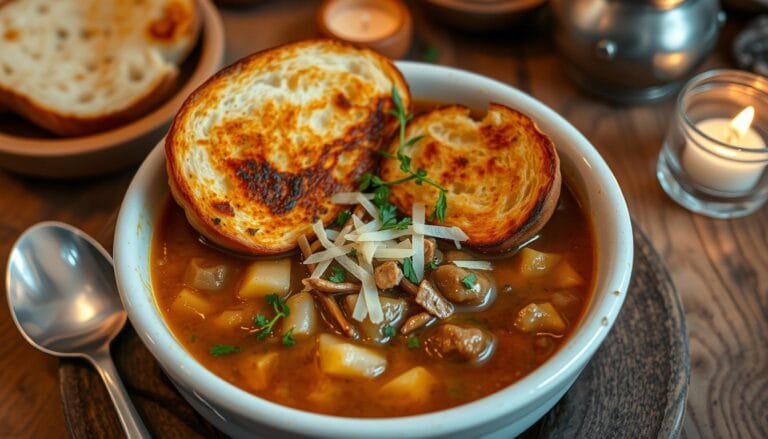I’ve always loved the flavors and textures of Pad Thai. But as a vegan, I wanted to make a version that’s just as tasty. This vegan Pad Thai with tofu recipe is my creation. It’s a quick, Thai-inspired dish that’s full of flavor, using simple ingredients.
Looking for a fast and tasty meal? This plant-based Pad Thai is perfect. It combines rice noodles, crispy tofu, crunchy veggies, and a rich sauce. It’s a meal that’s full of Thai flavors. Plus, you can make it your own, fitting it to your taste and diet.
Ready to try this tasty vegan Pad Thai recipe? Let’s make this Thai dish at home together!
What Makes This Vegan Pad Thai Special
This vegan pad thai is different from the traditional version. It uses plant-based ingredients instead of animal products. Instead of fish sauce and dried shrimp, it uses soy sauce, tamarind, and peanut butter. This gives it the sweet, sour, and umami flavors of pad thai.
The result is a delicious, cruelty-free take on the classic Thai noodle dish.
Quick and Easy 30-Minute Meal
This vegan pad thai recipe is quick and easy to make. You can have a satisfying plate of noodles in just 30 minutes. It’s perfect for busy weeknights when you want a flavorful, plant-based meal without a lot of fuss.
Perfect for Meal Prep
- The components of this vegan thai food dish can be prepared in advance, making it an excellent choice for meal prep.
- The noodles, tofu, vegetables, and sauce can all be prepped separately and then quickly combined when you’re ready to enjoy your meal.
- This setup allows you to have a delicious, easy pad thai ready to go at a moment’s notice.
With its plant-based twist on a takeout favorite, this vegan pad thai recipe is sure to become a new go-to in your weeknight dinner rotation.
Essential Ingredients for Plant-based Pad Thai with Tofu
Creating the perfect vegan pad thai starts with choosing the right ingredients. These ingredients should bring out the bold, balanced flavors of the traditional Thai dish. A few key components are at the heart of this vegan pad thai recipe.
The base of the dish is a high-quality rice noodle. I use 8 ounces of dried rice sticks, like Sun Voi brand, for their authentic texture and flavor. To add protein, I use 7 ounces of firm tofu, pressed and cubed to soak up the sauce.
The sauce is where the magic happens. It’s made from low-sodium soy sauce, rice vinegar, maple syrup, lime juice, and a bit of sriracha. Shredded carrots and sliced green onions add freshness and crunch. Optional toppings like mung bean sprouts, chopped peanuts, and cilantro enhance the vegan pad thai.
| Ingredient | Quantity |
|---|---|
| Dried rice noodles | 8 ounces |
| Firm tofu, pressed and cubed | 7 ounces |
| Low-sodium soy sauce | 1/4 cup |
| Rice vinegar | 2 tablespoons |
| Maple syrup | 2 tablespoons |
| Lime juice | 2 tablespoons |
| Sriracha | 1-2 teaspoons |
| Carrots, shredded | 1 cup |
| Green onions, sliced | 4 |
| Mung bean sprouts (optional) | 1 cup |
| Chopped peanuts (optional) | 1/3 cup |
| Cilantro (optional) | 1/3 cup, chopped |
By choosing these vegan pad thai ingredients carefully, you can make a dish that’s both authentic and plant-based. The mix of chewy noodles, crisp veggies, and flavorful sauce makes for a satisfying, nutritious meal. It will surely delight your taste buds.
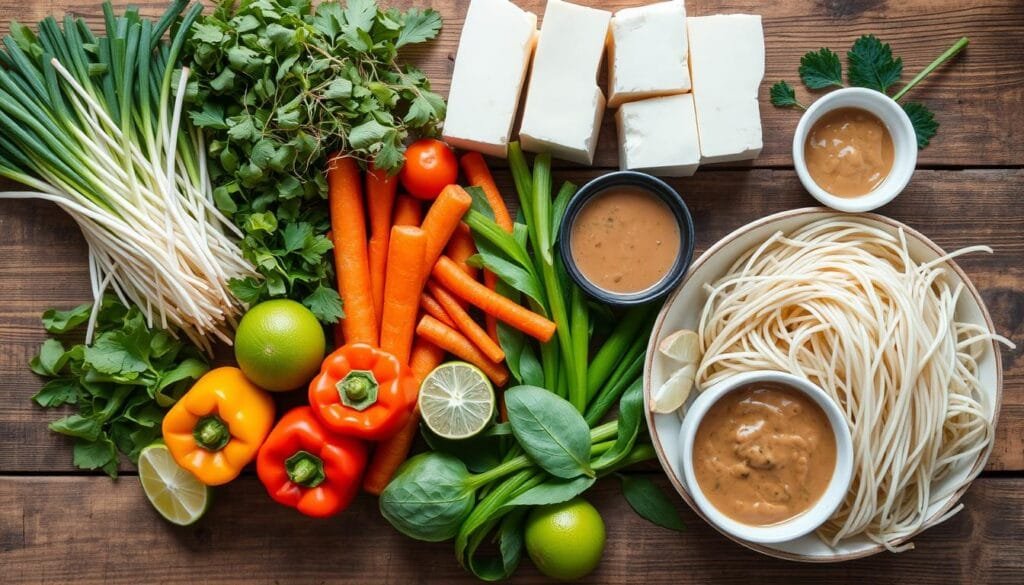
Creating the Perfect Vegan Pad Thai Sauce
Making the perfect vegan pad thai sauce is key to enjoying this beloved Thai dish. Traditional pad thai uses fish sauce and shrimp, but our version is plant-based. It combines savory, sweet, and tangy flavors for a taste that’s just as good.
Sauce Components and Substitutions
Our vegan pad thai sauce starts with these key ingredients:
- Soy sauce or tamari (for a gluten-free option)
- Rice vinegar
- Maple syrup
- Fresh lime juice
- Sriracha or other hot sauce
To get closer to the real flavor, add a tablespoon of tamarind concentrate. It’s tangy and sweet. If you can’t find tamarind, a tablespoon of ketchup works well as a substitute.
Balancing Sweet, Sour, and Umami Flavors
Creating a great vegan pad thai sauce means balancing sweet, sour, and umami flavors. Maple syrup adds a touch of sweetness. Rice vinegar and lime juice bring tanginess. Soy sauce (or tamari) and sriracha add savory depth.
By adjusting these ingredients, you can make the sauce just right for you. Use it on noodles, tofu, and veggies for a delicious plant-based meal.
How to Prepare and Press Tofu for Maximum Flavor
Getting the perfect texture and flavor from tofu is key for a great plant-based Pad Thai. We need to prepare and press the tofu right before marinating and cooking. Here’s how to get the most out of your tofu:
- Press the Tofu: First, take the tofu out of its packaging and pat it dry with paper towels. Wrap it in a clean towel and put it on a flat surface. Place a heavy object, like a cast-iron skillet, on top and let it sit for 20-30 minutes. This step removes excess water, making the tofu firmer and chewier.
- Cube the Tofu: After pressing, unwrap the tofu and cut it into 1-inch cubes. This size helps the tofu soak up the marinade well and keeps its shape while cooking.
- Marinate the Tofu: In a shallow dish, mix the tofu cubes with soy sauce, rice vinegar, sriracha, and maple syrup. Gently toss to coat evenly. Cover the dish and marinate for at least 20 minutes, or up to an hour for even more flavor.
By pressing and marinating the tofu properly, you’ll get a tasty protein that goes well with your plant-based Pad Thai.
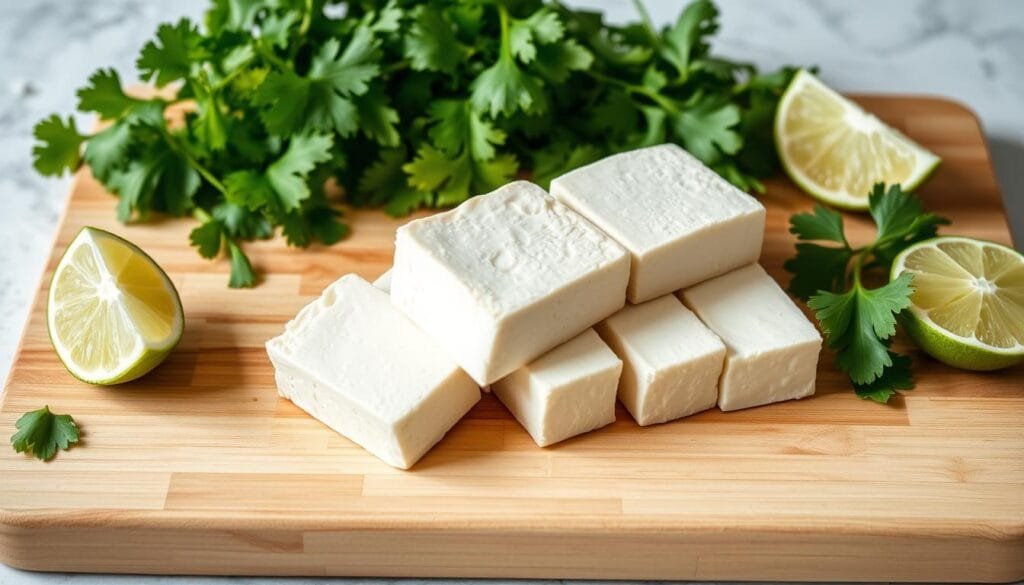
Step-by-Step Cooking Instructions
Making the perfect vegan Pad Thai is all about stir-fry mastery. Let’s go through the steps to make your dish delicious and just right.
Noodle Preparation Tips
The base of any great Pad Thai is the noodles. Vermicelli rice noodles work best with the sweet-and-sour sauce. Cook them for 5-7 minutes in boiling water until they’re tender but firm. Then, drain and set them aside.
Tofu Cooking Technique
For protein, use extra-firm tofu. To get a crispy texture, toss the tofu in oil and bake at 190°C (375°F) for 15 minutes, flipping halfway. This makes the tofu golden and crispy.
Combining All Elements
Now, it’s time to mix everything together. Heat a bit more oil in a large wok or skillet over medium-high. Add minced garlic and sliced green onions and sauté for 2 minutes. Then, add crisp veggies like broccoli, bell peppers, and carrots and stir-fry for 3-4 minutes.
When the veggies are slightly soft but crisp, add the noodles and tofu. Pour in the Pad Thai sauce and toss to coat everything evenly. Cook for 2-3 minutes more, until the sauce thickens and flavors blend.
To make a great vegan Pad Thai, cook fast and keep veggies crisp. Follow these steps to get that perfect sweet, sour, and savory taste in your homemade dish.
Customizing Your Pad Thai with Vegetables
This vegetable pad thai recipe is super versatile. It comes with carrots, broccoli, bell peppers, and sugar snap peas. But you can add or swap other veggies to make it your own. This way, you get a customized vegan recipe that you’ll love.
When adding new veggies, think about their cooking times. This keeps them crunchy and flavorful. Mushrooms, bean sprouts, and edamame are great choices. Try different veggies to make a vegetable pad thai that’s just right for you.
This recipe invites you to be creative and try new things. You can make it as veggie-heavy or simple as you like. So, go ahead and mix your favorite veggies to make a pad thai that’s all yours.
| Vegetable | Preparation | Cooking Time |
|---|---|---|
| Carrots | Julienned or grated | 5-7 minutes |
| Broccoli | Florets | 7-10 minutes |
| Bell Peppers | Sliced into strips | 5-7 minutes |
| Sugar Snap Peas | Trimmed and halved | 3-5 minutes |
| Mushrooms | Sliced | 5-7 minutes |
| Bean Sprouts | Whole | 2-3 minutes |
| Edamame | Shelled | 3-5 minutes |
To make a great vegetable pad thai, balance the cooking times. This keeps all the veggies fresh and colorful. With a bit of trial and error, you’ll make a plant-based pad thai that’s a hit with everyone.
Essential Toppings and Garnishes
Make your plant-based pad thai even better with tasty toppings and garnishes. These extras add flavor, texture, and make the dish look great. Let’s look at the key elements that will enhance your vegan pad thai.
Fresh Herbs and Citrus Options
Fresh herbs like cilantro and chives add a fresh taste to your pad thai. Chopped cilantro gives a green, aromatic flavor. Chives add a hint of onion taste. For a zesty touch, serve with fresh lime wedges. The lime’s bright citrus flavor goes well with the dish’s savory and sweet notes.
Crunchy Elements to Add
Adding crunchy toppings makes your vegan pad thai more interesting. Crushed or chopped peanuts add a nutty crunch. Mung bean sprouts bring a crisp, refreshing feel. For more texture, try pickled radish slices or toasted sesame seeds.
| Topping/Garnish | Quantity | Contribution to Dish |
|---|---|---|
| Chopped cilantro | ¼ cup | Adds freshness and aroma |
| Sliced chives | 2 tablespoons | Provides a subtle onion-like flavor |
| Lime wedges | 4 wedges | Delivers a zesty, brightening note |
| Chopped peanuts | ½ cup | Adds a delightful crunch |
| Mung bean sprouts | 1 cup | Offers a refreshing, crunchy texture |
| Pickled radish slices | ¼ cup | Provides a tangy, crunchy contrast |
With these vibrant pad thai toppings and vegan garnishes, your plant-based pad thai will look and taste amazing. It’s sure to impress your taste buds.
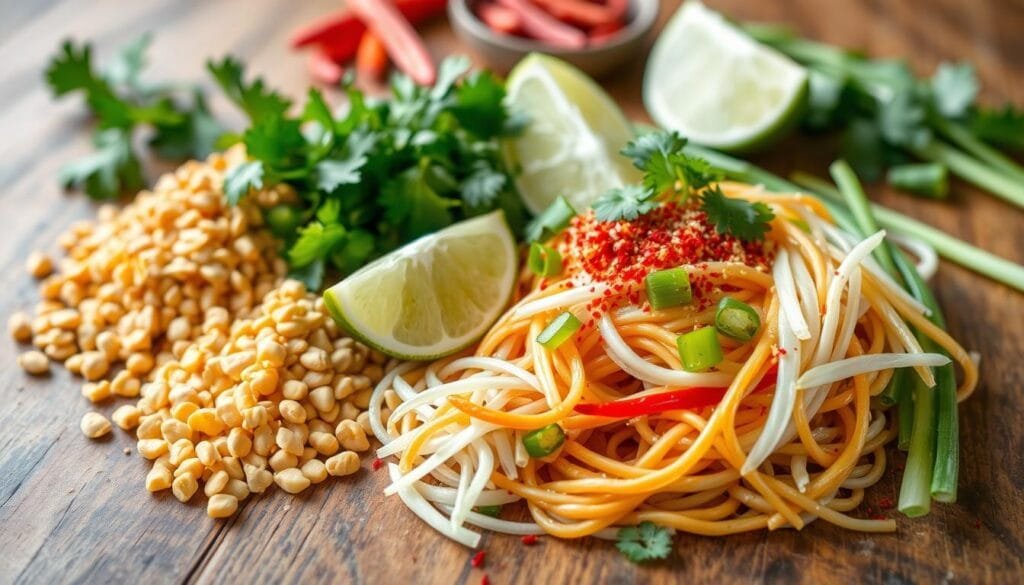
Storage and Reheating Guidelines
Storing and reheating your homemade vegan pad thai is easy with a few tips. This dish is best fresh, but you can store leftovers too.
Keep the noodles, sauce, veggies, and tofu in separate containers in the fridge. Noodles last 3-4 days, sauce up to a week, and veggies 1-2 days.
To reheat, mix everything in a pan and warm it up gently. Add water if the noodles get dry. This way, your dish stays tasty and fresh, even when it’s leftovers.
“The beauty of homemade vegan pad thai is that it can be enjoyed even days after you’ve cooked it. Just follow these easy storage and reheating guidelines, and you’ll have a delicious meal ready in no time.”
These tips are great for meal prep or enjoying leftovers. Your vegan pad thai will always be fresh and tasty. Enjoy!
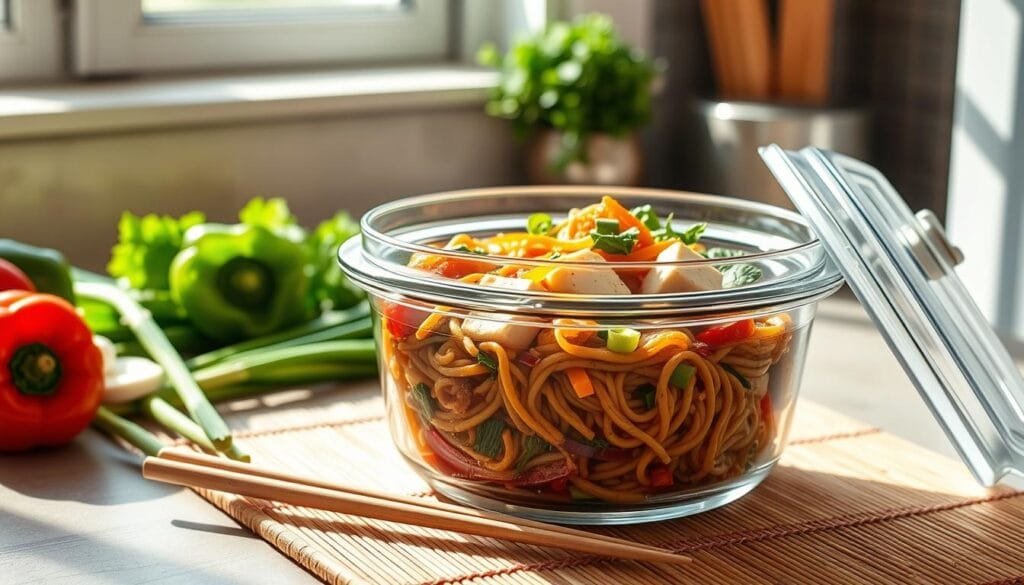
Recipe Variations and Dietary Modifications
This vegan pad thai recipe is super flexible. You can make it fit your dietary needs and likes. For a gluten-free version, use tamari instead of soy sauce. It’s a gluten-free choice.
To cut down on carbs, swap rice noodles for spiralized veggies like zucchini. Adding tempeh or edamame boosts the protein. You can also try different nut butters in the sauce for a new flavor.
Whether you’re gluten-free, low-carb, or vegan, this recipe is a tasty option. It lets you enjoy pad thai without giving up on your diet. With a bit of creativity and some simple changes, you can make this dish your own.
